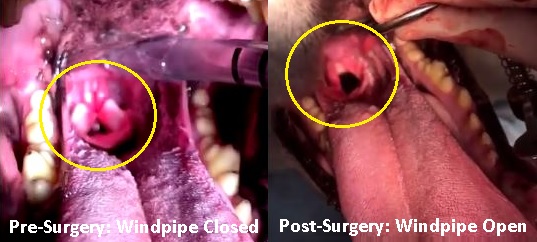Laryngeal Paralysis (LP) is the slowly progressive failure of the larynx to properly open, causing breathing problems for patients that can be not only extremely uncomfortable, but life threatening.
The opening of the windpipe, or trachea, has two cartilages called the Arytenoids, which open and close with each breath, allowing oxygen into the lungs.
In some aging dogs, especially large breeds, with Labradors being a high risk candidate for this problem, there is a progressive failure of these arytenoids to properly open and close. This can sometimes be slowly progressive over years, or sometimes very rapidly progressive over weeks. It is not uncommon to have these patients die suddenly, especially in hot whether where these dogs are not able to cool themselves properly.
Classically these patients exhibit increased respiratory noise on exercise, and often their bark has changed in nature becoming quite husky. These patients should be assessed under light anaesthesia to diagnose this potentially life threatening condition that can be successfully treated.

Surgery
The treatment for Laryngeal Paralysis is surgery, where one of the arytenoids is sutured permanently open to allow the airflow needed. Although this sounds simple, it is in fact an extremely complicated surgery, and only done by specialists and high quality general surgeons. At Southern Animal Health this is a surgery that we do often and with great success.
When should surgery be contemplated?
There are some risks with these surgeries, the main one being aspiration pneumonia. Because the windpipe is permanently open, it is possible for the patients to aspirate saliva or food down the trachea, causing inflammatory and bacterial pneumonia which in itself is sometimes life threatening. Hence in our opinion we do not recommend surgery for mild cases where the signs are subtle, and where the movement of the arytenoids is only partially impaired.
However we do teach the client what worsening signs to look out for and when to operate. Hence it depends on not only the clinical signs of the individual patient, but on the examination or the arytenoids themselves.
Once we do recommend surgery, it is because the risks of not doing surgery far out weigh the risks of doing surgery.
‘Holly’ the Labrad or
or
Holly is a 13 year old Labrador who came to us after another veterinary clinic had not found the problem to her breathing concerns.
Holly’s human mum called us to discuss her situation as the previous three months work up had not come to a diagnosis at the other vet clinic. Holly had become exercise intolerant, with increased respiratory noises upon exercise, and a very significant change to her bark, having become hoarse of recent weeks. We advised that LP (Laryngeal Paralysis) will be the problem, and she was due to come and talk to us regarding surgery the following week.
Unfortunately, Holly was rushed to us the very next morning as she could not breathe properly and had completely collapsed. It is not unusual for LP patients to collapse suddenly, often dying within hours. Holly’s family were left having to make the immediate decision to perform emergency LP surgery.
Although usually sent to a specialist by most general practices (when you can get them!), our head surgeon Dr Davids does this surgery regularly – which is one of the advantages of being a SAH client! Unfortunately however, Karin was on holidays but she answered the phone upon our emergency call, having only returned from interstate the day before, and within the hour had Holly on the operating table.
The following videos show her condition before and after surgery.
Pre-Surgery – Note how closed her windpipe is and how much trouble she’s having breathing
Post-Surgery – Note how open her windpipe is and how she can now breathe with ease
From these it is easy to see what the problem is, and why these patients do so much better once corrected. Holly was lucky, close to being one of the ones that die suddenly. Ideally this condition should have been diagnosed and acted upon months earlier before becoming so bad.
Holly was also suffering quite badly from arthritis in the previous six months, being treated with chondroprotective injections and anti inflammatories. Although not guaranteed, we often advise that dogs who can’t get enough oxygen because of their LP can struggle a lot more with arthritis, and it is not uncommon to see this also improve after surgical correction. Holly certainly found this to be the case, getting around much better than she had for some time. It’s remarkable how much better life is when you can breathe properly!
View the lovely Holly happy and enjoying life. You may read a testimonial straight from Holly’s owner by clicking here.
